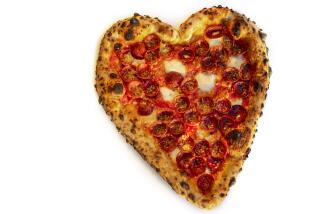Virtual Roses : Technology Horns In on Valentine’s Day
- Share via
The traditional Valentine’s Day gestures and the billions of commercial dollars they generate each year--in flowers, cards, chocolates, fine dining, silk undies--seem in little danger of being eclipsed by technology.
Just last year, American consumers are said to have romanced their valentines with a billion greeting cards, 150 million roses, $1 billion worth of jewelry and 30 million heart-shaped boxes filled with candy.
Still, at a time when couples who meet chatting on the Internet can wind up at the altar, perhaps after a steamy computer-enhanced romance, old-fashioned Valentine sentiments may find new expression in state-of-the-heart high-technology.
Isn’t it romantech?
For instance, there is jewelry made from microchips. You can send a floral hologram or profess your love in a multimedia presentation. Even Johnny Mathis croons “Chances Are” on laser disc. In fact, one may wonder whether Cupid has produced a digital clone intent on fiber-optic matchmaking.
“The relationship between courtship and technology is not a new one,” says Clifford Nass, a Stanford professor who studies the dynamics of technology and human nature. “As a technological system matures, it passes from its original, ‘sacred’ purpose to more social and commercial applications.”
For example, Nass says, the telephone was at first intended only for professional or emergency use, and customers were cautioned against making personal calls. “That’s a far cry from, ‘Reach out and touch someone,’ ” he notes.
Indeed, that AT&T; jingle is taking on more meaning with the advent of so-called virtual reality on the computer screen, where all manner of erotic behavior has become possible via technology.
But romance, not soft-porn software, is the subject here. So what might the romantech-ally inclined bestow upon his or her Valentine as they stroll interactively down the information superhighway of life?
Diamonds may be forever, but recycled computer components are cheaper. Integrated circuit boards, microchips, light-emitting diodes, capacitors and fuses are being forged into earrings, string ties and worse.
There are amorous computer screen savers with little red hearts and doilies bouncing around. You can have your PC recite Elizabeth Barrett Browning instead of the usual bleeps and bongs after logging on. There are greeting cards with a tiny microphone that can record a 10-second message. Electronic greeting cards along with e-mail “Cupidgrams” may, as usual, be found on the on-line services.
So has Valentine’s Day been twisted out of shape? If so, it happened long before this. The day, dating to a Roman festival of romance and fertility, has become, like many holidays, a commercial extravaganza.
Flowers remain the most popular gift--it is the biggest sales day of the year for florists. Florimex, the big exporter and importer of flowers, does 20% of its business on Valentine’s Day, nearly $2 million in California alone last year. The company expects a 35% rise this year.
With fine dining recovering from recessionary doldrums, restaurateurs also figure on a good day. Similar bullishness emanates from practically everyone else with financial stakes in the day.
It is an especially important holiday to the candy people, whose sales have generally declined in recent years. But chocolate is an experience that so far hasn’t been technified. Nobody is selling chocolate “chips.”
So go ahead, give chocolate. You can always follow up with some diet and exercise software.
Times staff writer George White contributed to this article.






